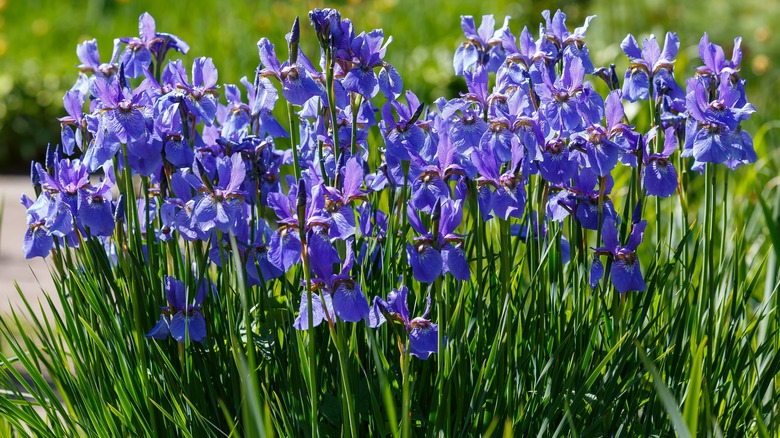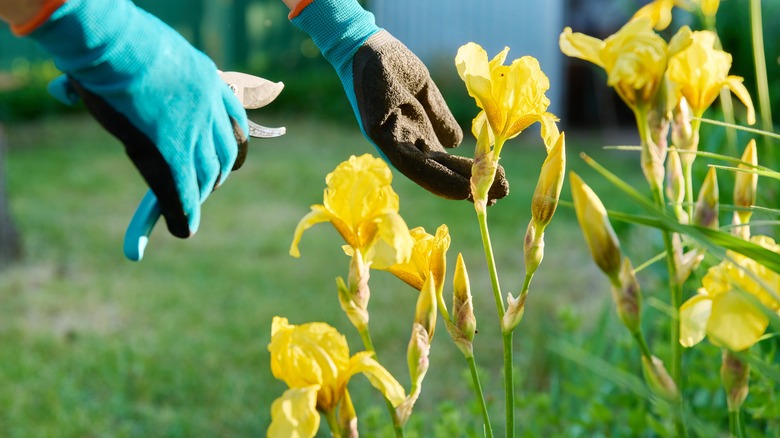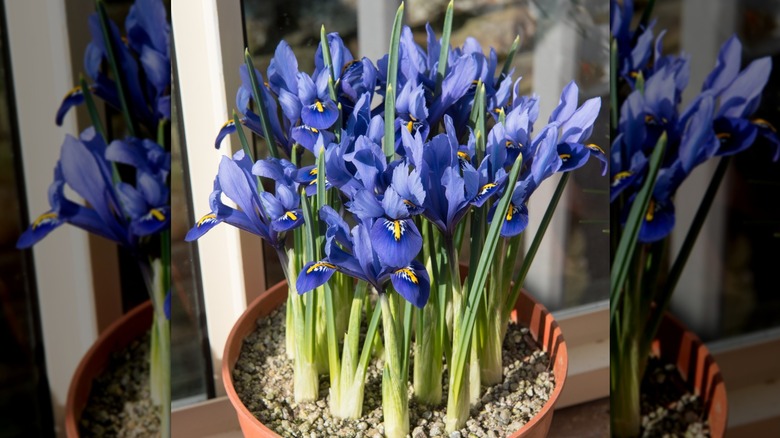How To Keep Your Iris Safe From Freezing Winter Temperatures
A steady fixative in most perfumes, the iris plant — named after the rainbow-riding Greek goddess — has become a regular feature in ornamental gardens, thanks to its iridescent inflorescence. Hardy to zones 3 to 9, the six-petaled flower plant can effortlessly survive in cold climates, making it easy to care for. Yet, based on the cultivar variety, its age, and climate conditions, you may need to deploy some steps to overwinter the sweet-smelling plant suitably.
For instance, in locations with frosty conditions, the irises must be protected with straws or dead leaf-based structures that are otherwise unnecessary in the more benign winters. Similarly, it's essential to deeply water the younger plants before winter to promote better anchorage, or else they'll suffer cold damage due to the relentless freeze-thaw cycles common in chilly locations. Likewise, cold, hardy varieties like Siberian iris and Japanese iris can do with a little mulching during the winter, but you may have to dig out the rhizomes of other varieties and recultivate them come spring.
Overwintering iris plants
For irises, winter care begins with fall pruning. This is done to lend them protection against acute fungal diseases and pests like leaf spot and borers, whose spores and eggs remain dormant in the dead foliage through the cold and activate in the growing season. To do so, tug out all the wilted flowers and foliage and deadhead the remainder using sharp clippers to nearly 6 inches above the ground. While you're at it, ensure you have thoroughly removed all spotted, diseased parts (if any) and shape the remaining leaves into an upright triangular shape.
Once the ground freezes, cover the soil with a 1-to-2-inch-wide sand or mulch layer and top it up with evergreen branches. This is particularly crucial for newly-rooted iris plants, as the frequent freezing and thawing cycles make them susceptible to heaving, meaning they're easily displaced from the ground under the cyclic impact. Moreover, it insulates them against frost damage. However, ensure the mulch isn't water-retentive, as irises despise wet feet. Not to mention, wet soils can cause root rot and promote fungal growth. Oat or wheat straws and hay are viable options, but avoid grass clippings at all costs. That being said, if ensuring proper drainage is a tall task, then lift out the rhizomes and store them in the basement or a garage for the winter.
Other winter care tips
Like garden-planted irises, their containerized counterparts also need winter protection. Irrigate them occasionally if the soil is dry to the touch and the temperatures remain over 45 degrees Fahrenheit. In areas experiencing winter rain, add gravel or sand to the potting material to ensure the rhizomes don't remain standing in water. Also, cover the containers with mesh or burlap to keep hungry critters like squirrels from munching on your hardy perennials and provide wind insulation. Alternatively, bring the pots indoors if the weather is extremely harsh and place them back when spring sets in.
As for the ground-planted irises, stagger the removal of dead leaves and the mulch once the snow melts and the temperatures rise to 50 degrees Fahrenheit or more. Start by taking off the top layer to expose the ground underneath to sunlight and drying it completely. Follow it up with the complete removal of the mulch layer on a hot day while making sure plant foliage and branches suffer no breakage. Also, check for any signs of dry rot and deal with it by cutting out the damaged parts or treating them with a fungicide.


